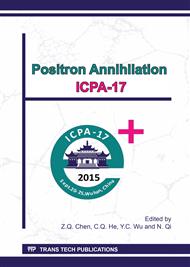p.155
p.162
p.167
p.171
p.179
p.183
p.189
p.193
p.197
Study of Defects in Croconic Acid Single Crystals Using Positron Annihilation Lifetime Spectroscopy
Abstract:
Croconic acid is the first single molecular organic ferroelectric material exhibiting very high spontaneous polarization (~ 20 μC/cm2) at room temperature. Maximizing polarization depends on minimizing void defects in croconic acid crystals. In this experiment, the change in void defects upon the thermal treatment is characterized using positron annihilation lifetime spectroscopy. Both defect void size and intensity are measured, and their dependence upon the thermal treatment duration is studied. In addition, the relation between the void defect and ferroelectric hysteresis of croconic acid is established.
Info:
Periodical:
Pages:
179-182
Citation:
Online since:
March 2017
Keywords:
Price:
Сopyright:
© 2016 Trans Tech Publications Ltd. All Rights Reserved
Share:
Citation:


